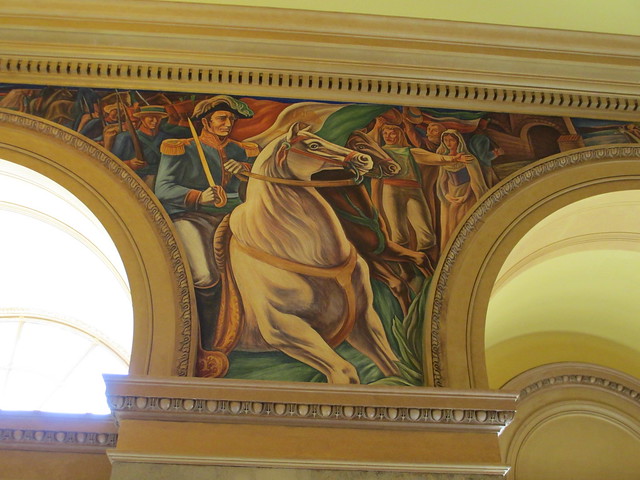One of the joys of my new position here at the Roswell Museum and Art Center is that I get to work with an incredible collection of works on paper. As a printmaker (albeit an amateur), I can't tell you how thrilling it is to engage with such a diverse array of etchings, lithographs, serigraphs, and other prints.
For this inaugural relaunch of Printmakers You Should Know, then, I'm going to highlight one of the superstars from the RMAC collection: Howard Cook.
 |
| Howard Cook, Self-Portrait, 1958, oil on unstretched canvas. Image courtesy of the Roswell Museum and Art Center. |
Howard Norton Cook (1901-1980) was originally from Springfield, Massachusetts, but was one of the great globetrotting artists of the 20th century, visiting Europe, Mexico, the South Pacific, and other places. He studied at the Arts Student League in New York, and one of his teachers was none other than Andrew Dasburg, one of the American artists to be featured in the seminal Armory Show of 1913. In his spare time, Cook painted billboard signs and worked in lithography and photogravure shops. After a sojourn in Europe, he studied printmaking in earnest with Joseph Pennell, taking up etching, woodcutting and wood engraving.
Cook started out his artistic career as an illustrator for Forum magazine and other publications. In 1926, he traveled to New Mexico on assignment for Forum to create Southwestern-themed woodcuts.
 |
| Howard Cook, Governor's Palace, Santa Fe, 1927, woodcut, about 8'' x 8''. Image courtesy of Roswell Museum and Art Center. |
What was supposed to be a six-month excursion ended up lasting well over a year, with Cook spending time in both Santa Fe and Taos. It was a fateful trip, as Cook would not only meet and marry his wife, Barbara Latham (another printmaker you should know, and will know next month), but would also become entranced with the land itself, eventually settling there permanently.
During the 1930s Cook was lucky enough to snag not just one, but two Guggenheim Fellowships. The first would take him to Taxco, Mexico, where he would learn the fresco techniques of Diego Rivera and the other great Mexican muralists of the period. He would also continue to make prints. The second would take him to the American South, where he would create numerous sketches and preparatory drawings for future prints and frescoes.
During the 1930s, Cook worked as a muralist for the W.P.A., painting frescoes for the Pittsburgh Courthouse, the San Antonio Post Office, and the Corpus Christi Post Office, among other places.
 |
| Howard Cook, San Antonio's Importance in Texas History, 1937-1939, fresco. At the time of its commission, this was the largest WPA mural project in the United States. Image courtesy of http://archpaper.com/news/articles.asp?id=6583. |
 |
| Detail of the San Antonio fresco. Image courtesy of http://www.flickr.com/photos/courthouselover/8373840795/ |
 |
| Another San Antonio detail. Image courtesy of http://farm9.staticflickr.com/8233/8374913264_6312b07982_z.jpg |
During World War II, Cook became an art correspondent for the Navy, traveling to the South Pacific. After the war he and Barbara Latham continued to travel and work prolifically, living primarily in Taos, until multiple sclerosis slowed him down.
As a printmaker, Cook was a technical master, and I get both chills of excitement and a little sting of envy when I look at his work. He could do etching, aquatint, woodcuts, linocuts, wood engraving, and lithography with equal skill and finesse (interestingly though, he never seems to have gotten in serigraphy, which was being explored in the 1930s by such Southwestern-based artists as Louie Ewing). Each technique has its own particular demands and idiosyncrasies, so the fact that he could work equally well with all of them is impressive. I mean, look at these:
 |
| Howard Cook, Mexican Interior, 1933, etching. Image courtesy of Roswell Museum and Art Center. |
 |
| Howard Cook, Rosanna, 1939, lithograph. Image courtesy of Roswell Museum and Art Center. |
 |
| Howard Cook, Giant's Thumb, 1927, woodcut. Images courtesy of Roswell Museum and Art Center. |
The other admirable thing about Cook is that he never stopped exploring. Having mastered so many printmaking techniques, he could have easily dedicated the rest of his career to making prints, but he didn't. Instead, he diminished his printmaking output after the 1930s in order to focus on different media such fresco, watercolor, tempera, oil, even collage. Moreover, he experimented with his style throughout the decades, becoming increasingly abstract. Throughout his life he kept investigating new possibilities, and that, in my opinion, is how we should all try to live and create.
Want to learn more? Of course you do, so check out these sites:
http://www.howardnortoncook.com/
http://americanart.si.edu/collections/search/artist/?id=979
You can also search the RMAC's holdings of Howard Cook in our Past Perfect database:
http://roswellmuseum.pastperfect-online.com/36727cgi/mweb.exe?request=ks
For WPA murals in general:
http://www.wpamurals.com/
For those of you who prefer books, there's The Graphic Work of Howard Cook: A Catalogue Raisonne by Betty and Douglas Duffy (Bethesda Art Gallery, 1984). Look it up on Worldcat to find it in the library nearest you.
Comments
Post a Comment
Questions? Comments? Speak your mind here.